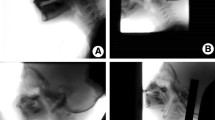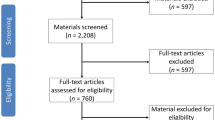Abstract
The videofluoroscopy swallowing study (VFSS) is regarded as the gold standard in diagnosing and assessing swallowing disorders. The goal of this study was to evaluate patients’ radiation dose during a VFSS and to determine the influence of patients’ underlying characteristics on radiation exposure risk. A total of 295 patients who underwent VFSS were included in this study. The fluoroscopy machine was equipped with a dose area product (DAP). The mean screening time was 4.82 ± 1.80 min and the mean DAP was 9.62 ± 5.01 Gy cm2. The mean effective dose was 1.23 ± 0.64 mSv. Screening time and DAP had a positive correlation (r = 0.76, P < 0.0001). The cerebrovascular accident (CVA) group showed higher screening time and DAP than the nasopharyngeal cancer (NPC) group with statistical significance. Patients’ BMI and DAP had a positive correlation (r = 0.28, P < 0.0001), and height, weight, and body surface area (BSA) also showed positive correlations with DAP. Radiation dose during VFSS is much lower than that of a routine chest CT, and it would take more than 40 VFSSs annually to exceed the annual radiation exposure dose limit according to the mean effective radiation exposure dose of this study. As it is difficult to exceed the annual dose limit, we assume that VFSS is relatively safe in terms of its radiation exposure risk.





Similar content being viewed by others
References
Wright RE, Boyd CS, Workman A. Radiation doses to patients during pharyngeal videofluoroscopy. Dysphagia. 1998;13:113–5.
Martin-Harris B, Logemann JA, McMahon S, Schleicher M, Sandidge J. Clinical utility of the modified barium swallow. Dysphagia. 2000;15:136–41.
Logemann JA. Role of the modified barium swallow in management of patients with dysphagia. Otolaryngol Head Neck Surg. 1997;116:335–8.
Baker G. Ionising radiation regulations. Vet Rec. 1985;117:646.
International Commission on Radiological Protection. 1990 recommendations of the International Commission on Radiological Protection, Annals of the ICRP 21. Oxford: Pergamon; 1991.
Chau KH, Kung CM. Patient dose during videofluoroscopy swallowing studies in a Hong Kong public hospital. Dysphagia. 2009;24:387–90.
Geise RA. Fluoroscopy: recording of fluoroscopic images and automatic exposure control. Radiographics. 2001;21:227–36.
Tsushima Y, Taketomi-Takahashi A, Takei H, Otake H, Endo K. Radiation exposure from CT examinations in Japan. BMC Med Imaging. 2010;10:24.
Smith-Bindman R, Lipson J, Marcus R, Kim KP, Mahesh M, Gould R, Berrington de Gonzalez A, Miglioretti DL. Radiation dose associated with common computed tomography examinations and the associated lifetime attributable risk of cancer. Arch Intern Med. 2009;169:2078–86.
Calvanio R, Levine D, Petrone P. Elements of cognitive rehabilitation after right hemisphere stroke. Neurol Clin. 1993;11:25–57.
Geschwind N. The apraxias: neural mechanisms of disorders of learned movement. Am Sci. 1975;63:188–95.
Kelly H, Brady MC, Enderby P. Speech and language therapy for aphasia following stroke. Cochrane Database Syst Rev. 2010;5:CD000425.
Kuon E, Glaser C, Dahm JB. Effective techniques for reduction of radiation dosage to patients undergoing invasive cardiac procedures. Br J Radiol. 2003;76:406–13.
Ector J, Dragusin O, Adriaenssens B, Huybrechts W, Willems R, Ector H, Heidbuchel H. Obesity is a major determinant of radiation dose in patients undergoing pulmonary vein isolation for atrial fibrillation. J Am Coll Cardiol. 2007;50:234–42.
Conflict of interest
Financial disclosure statements have been obtained and the authors declare no conflict of interest to disclose.
Author information
Authors and Affiliations
Corresponding author
Rights and permissions
About this article
Cite this article
Kim, H.M., Choi, K.H. & Kim, T.W. Patients’ Radiation Dose During Videofluoroscopic Swallowing Studies According to Underlying Characteristics. Dysphagia 28, 153–158 (2013). https://doi.org/10.1007/s00455-012-9424-y
Received:
Accepted:
Published:
Issue Date:
DOI: https://doi.org/10.1007/s00455-012-9424-y




